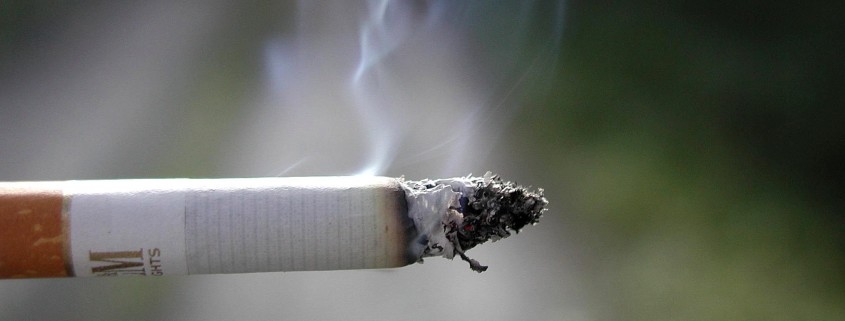It’s time for USC to become smoke-free
Earlier this month, students received an email from Dornsife Vice Dean for academic programs Steven Lamy on Smoke-Free Campus Coalition’s anonymous survey to gauge student input about smoking on campus, reigniting the debate over a campus-wide ban on smoking. A move to make campus smoke-free would demonstrate USC’s commitment to student health, as a progressive university dedicated to not only discussion, but action and implementation as well.
At USC, current restrictions prohibit smoking within 10 feet of outdoor dining areas and in enclosed buildings, vehicles and “smoke-free” designed areas. These areas, however, aren’t clearly delineated, and these rules are poorly enforced.
In April 2013, UCLA became the first UC school to implement a ban on cigarette smoke in the name of public health. By 2014, the entire UC system banned cigarettes and all other tobacco products from its campuses to protect nonsmokers from secondhand smoke and prevent young adults from developing a life-threatening addiction. As of Jan. 1, there are more than 1,475 smoke-free campuses across the nation, according to the Americans for Nonsmokers’ Rights Foundation.
It’s about time that USC aligned itself with the regulations of other universities. On Oct. 1, 2010, USC hospitals on the Health Science Campus became smoke-free.
University Park Campus shouldn’t be any different.
The debate around a smoke-free campus has been years in the making. In April 2010, the Academic Senate passed resolutions in support of a smoke-free campus and the USC Staff Assembly soon followed suit, passing a resolution of its own. In October 2011, the Undergraduate Student Government introduced a senate resolution recommending the addition of designated smoking areas and increased enforcement. And in April 2013, USG passed a resolution to form a student-run committee to investigate alternatives to the current smoking policy.
Ultimately though, a large culture shift will need to take place for the ban, if passed, to work as intended. All members of the university community need to take the responsibility to adhere to and enforce the policy, and to bring it to the attention of visitors and guests.
Arguments against a campus-wide ban cite infringement on students’ rights to smoke. While it is true that individuals have the choice to smoke, that right also infringes upon the health of others.
Some argue that a complete ban would demonstrate a lack of sensitivity for students who come from a culture or country where smoking does not carry the stigma it does here. While this is true to some extent, according to a 2014 report by the USC American College Health Association, 80.3 percent of international students and 68.3 percent of domestic students have never smoked cigarettes. The percentage of domestic students who report smoking cigarettes one or more days in the last month — 10.4 percent — was greater than the percentage of international students who did (8.0 percent).
If indeed USC becomes smoke-free, to facilitate the transition, it should offer more resources to help smokers quit. From over-the-counter meds to counseling programs, students need help bearing the brunt of the costs of quitting. UC Berkeley, which became tobacco-free at the end of 2014, provides free nicotine replacement therapy through University Health Services. CDC studies have shown that with fewer places to smoke, people are more likely to quit.
In addition, college seems to be a time when many begin smoking.
“Virtually nobody starts smoking after age 24 or 25,” Dr. Stanton Glantz, director of UCSF’s Center for Tobacco Control Research and Education, told SF Gate. “If you can get people through the college ages and a little bit past, and they’ve either not started or they’ve stopped, then they’re pretty well taken care of.” This note goes hand-in-hand with the California Senate’s decision to raise the smoking age in the state from 18 to 21, last August.
Even without a campus-wide ban, current policies must be re-addressed. The current regulations are loosely defined and poorly enforced. For a future campus-wide ban to be effective in any way, the University must first find more effective ways to enforce its current restrictions.
According to state and national public health reports, California currently has one the lowest rates of smoking in the nation — approximately 12 percent of residents smoke, while nationwide, 19.6 percent smoke. To continue this positive trend, USC should commit to a smoke-free campus — not to punish smokers, but to move forward with public health. It’s time to clear the haze and commit to a healthier, cleaner campus.
Daily Trojan Spring 2016 Editorial Board


As an alum (’00) and faculty member (Keck School of Medicine) who is allergic to smoke, I’ve been longing for a smoke free campus, seemingly forever. Sadly, I’ve learned not to hold my breath, as my letters to administration have gone unanswered. It’s unfortunate that USC remains years behind the rest of our nation’s colleges and universities with regard to eliminating such a harmful and obvious health risk, in the name of infringing upon the “culture” (?) of international students. Shouldn’t we as an institution of higher learning be educating all our students about the health risks of tobacco and helping them to quit? By the way, the Health Sciences Campus is not smoke-free at all; I routinely have to hold my breath walking across campus, always getting caught in the path of some smoker (usually an employee). I actually became hopeful a few years ago when a renowned expert on secondhand smoke, cancer and respiratory disease, who chairs the Clean Air Scientific Advisory Committee of the U.S. EPA and the FDA’s Tobacco Products Scientific Advisory Committee, joined our medical faculty. But alas, nothing has changed; I’m still chasing smokers away from windows, doors, and the loading dock in order to keep the cigarette smoke out of my office (last week, several construction workers were actually smoking indoors, filling my windowless office with smoke!). Step up, USC – it’s waaay past quitting time.